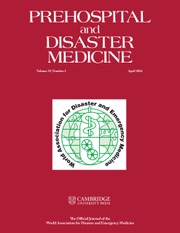No CrossRef data available.
Article contents
EMT Simulation-Based Team Training: Converting TEAMS 3.0 to a Virtual Format
Published online by Cambridge University Press: 21 May 2025
Abstract
Effective disaster response requires standardized training of Emergency Medical Teams (EMTs). The TEAMS 3.0 training initiative, initially designed for in-person training, has been shown to significantly improve team efficacy. However, logistical challenges and the COVID-19 pandemic have prompted the need to develop and assess virtual training alternatives.
This study compares EMT trainee experiences in TEAMS 3.0 virtual and in-person programs using qualitative thematic analysis.
Sixteen Canadian EMT volunteers participated in a condensed, one-day TEAMS 3.0 program. Sessions were held in-person (6 trainees, 4 trainers) and virtually (10 trainees, 6 trainers). Each session included four exercises with 30-minute debriefs, which were recorded and transcribed. Thematic analysis of transcripts was done in NVivo version 14.
Thematic analysis revealed key components of effective training in both formats. Access to EMT-specific SOPs and documentation templates were identified as being crucial for learning and exercise success. However, the virtual format negatively impacted communication and team connection during training activities.
Both formats supported the development of team skills and sparked essential discussions for successful deployment. Despite challenges in virtual training, such as impaired communication and participant connection, converting TEAMS 3.0 to a virtual format is a viable method of EMT training.
Information
- Type
- Meeting Abstracts
- Information
- Copyright
- © The Author(s), 2025. Published by Cambridge University Press on behalf of World Association for Disaster and Emergency Medicine


